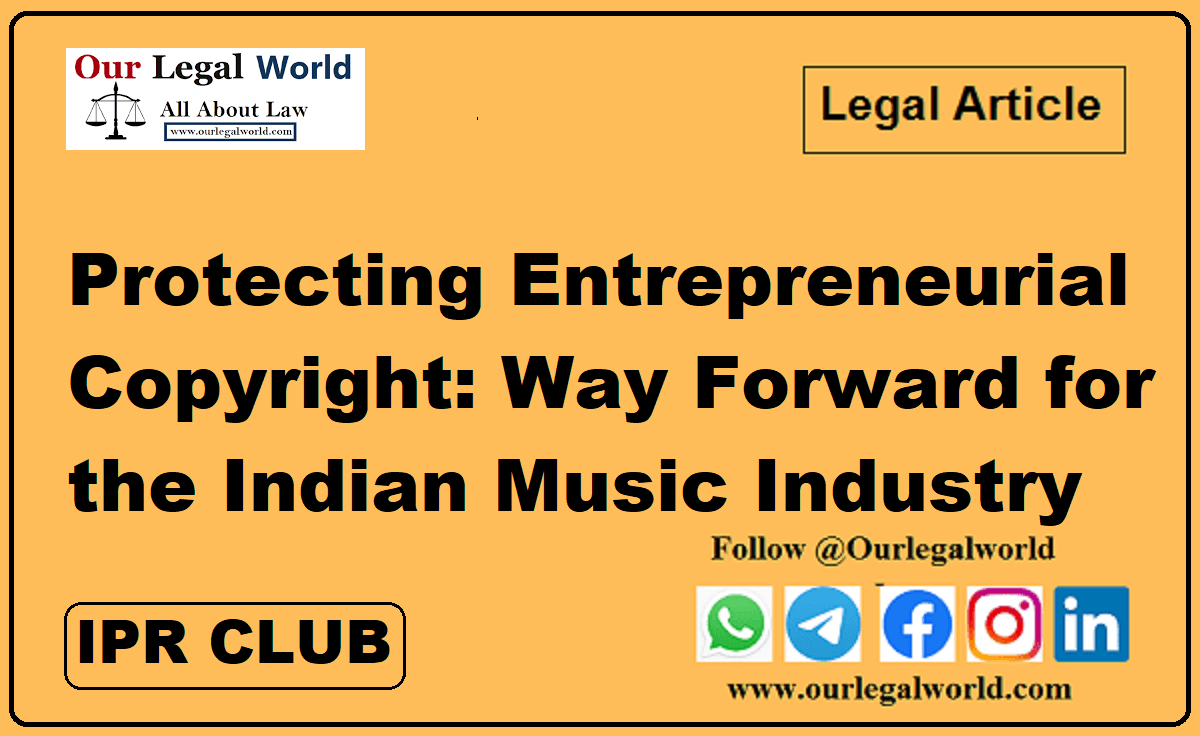Protecting Entrepreneurial Copyright: Way Forward for the Indian Music Industry
Meta Description
Recently the Indian Council for Research on International Economic Relations released a report titled ‘The Untold Potential of India’s Informal Music Industry. With inputs from industry insiders, it is claimed in the report that though the industry is growing it is lagging behind its international counterparts. The report states that one of the “sorest points” for the industry is the poor enforcement of intellectual property rights. To understand how revenue can be increased to bring the music industry on par with its global counterparts it is necessary to understand the intellectual property rights of the music industry which need to be protected.
In general, the intellectual property interests of the music industry around the globe lie in the authorial and entrepreneurial copyright. Historically the music industry has been concerned about protecting its works through authorial copyright. However, in today’s digital era the phenomenon of digital sampling, user-generated content, and peer-to-peer file sharing of music are examples which show how both the authorial right in the musical work and the neighbouring right in the sound recording can be infringed with the help of easily available technology. This article in the first part explores the interest of the global music industry in its authorial copyright. The second part of the article explores its concerns in protecting their entrepreneurial copyright. The article concludes by pointing out that to rectify the problems facing the Indian music industry an active stance is needed in protecting not just its authorial but entrepreneurial copyright as well.
Keywords– Indian music industry, revenue generation, authorial copyright, entrepreneurial copyright
Introduction
In a recent report by the Indian Council for Research on International Economic Relations titled ‘The Untold Potential of India’s Informal Music Industry,’ it is claimed that the Indian music industry is not realising its full potential. Unlike other countries, there is no proper enforcement of intellectual property laws which leads to a loss in revenue for the industry.[1] The most valuable IP asset for the music industry is the copyright material it is producing daily. Historically the music industry has been concerned about protecting its works through authorial copyright. However, in today’s digital era the phenomenon of digital sampling, user-generated content, and peer-to-peer file sharing of music has eased the way to make and distribute infringing copies. This hampers the growth of the music industry and chokes its development. In this scenario protecting both the authorial right in the musical work and the neighbouring right in the sound recording becomes significant.
Authorial Copyright
The meaning of music was explored in the case of Sawkins v. Hyperion Records[2] by the UK Court of Appeal where Mummery LJ observed that music is about combining sounds for listening so that it produces an effect on its listeners. In India, we find that the Hon’ble Supreme Court also made similar observations in the case of the Indian Performing Rights Society v. Eastern Indian Motion Pictures Association[3]. Since music can be a mixture of lyrics and sound, copyright law protects these two things separately. They are given separate protection as literary works and musical works under authorial copyright.This is important for the music industry especially the composers and lyricists, as these works are the original creations of the artists. This copyright involves the‘content’ they make[4]. The rights over authorial works have been given to rights-holders under Section 14(a) of The Copyright Act 1957 in India. A similar right is given in the UK under Section 16 of the Copyright Design and Patents Act 1988 (CDPA) and in the EU under Article 2 of the Info. Soc. Directive.
Entrepreneurial Copyright
Apart from the authorial copyright, another interest of the music industry is in protecting the ‘signal’ through which their music is delivered to their audience. This signal in most cases is through a sound recording. Copyright law protects these rights as neighbouring or derivative or entrepreneurial rightssince they are not independent but derived from the existing authorial work. One of the biggest differences between them is that works protected by authorial rights must be original whereas entrepreneurial works need not be original, they should just not be copied.[5] In India, the rights over these works are protected by Section 14 (e) of The Copyright Act 1957. In the UK this right is protected by under section 16 CDPA 1988 and in the EU under the Info. Soc. Directive and Related Rights Directive.
Also Read: PARLIAMENTARY STANDING COMMITTEE REPORT ON THE IPR REGIME
With the coming of the technological era protecting these rights has become a primary concern of the music industry. It is the interest of the investors like the record labels which is at stake, interwoven with the interests of the creators of music. In India, there is an interesting aspect to these rights in The Copyright Act 1957. Section 31D of the Act provides for statutory licences for broadcasting literary and musical works and sound recordings. Defences like fair use or de minimis use and getting a license from the copyright holder can be used to deflate infringement cases. These defences are provided in many jurisdictions however their application has been subjected to a lot of judicial scrutiny. In India, the Bombay High Court in the case of Tips Industries vs Wynk Music[6]while deciding the viability of section 31D of the Copyright Act 1957 for online streaming held that this section only applies to radio broadcasting and not to internet broadcasting. The Bombay High Court in the case of Sony Music Entertainment India vs KAL Radio Limited and Anr[7] balanced the rights of owners of sound recordings and the people wanting to use their copyright. The court held that the requirement of Section 31D should be strictly complied with by any party wanting to get a license. As far as the de minimis defence is concerned courts in foreign jurisdictions are more strict in granting it. The UK High Court in Hyperion v Warner Music[8] decided that infringement in cases of sound recording can happen by copying a substantial part of the plaintiff’s work even if it is unrecognisable in the defendant’s final work. In the case of Produce Records Limited v. BMG[9]even a small sample of 7.5 seconds taken from the plaintiff’s sound recording was found to be infringing.
Coming to EU, the most prominent case as regards the usage of the de minimis defence is the landmark CJEU judgement Pelham GmbH et al v Hutter, Schneider[10] the court took an innovative stance and balanced the freedom of arts with the property rights of rightsholders. The court held that the rights of the phonogram holders is limited to the extent that the sample used in the new work is modified enough so that it is unrecognizable to the ear.
Another jurisdiction worth exploring is USA. There the neighbouring rights are not recognised explicitly. Sound recordings are nevertheless protected as original works of authorship under Section 106 of the Copyright Act 1976. In case of Grand Upright Music v. Wraner Bros.[11] taking of three words and a portion of music from the plaintiff’s work was seen as infringement. In Bridgeport Music v. Dimension Film[12] the court departed from the de minimis test and ruled that there will be infringement if there is copying howsoever small the size of sample maybe. However, in the case of VMG Salsoul v Madonna Lousie Ciccone[13] the court applied the de minimis rule again and found that the copying from the sound recording by the defendant was trivial and hence not an infringement. These cases help in developing, clarifying and expanding the law related to the protection of intellectual property rights of the creative industry.
Conclusion
With rapid changes happening in the digital world and the increasing plasticity of music protecting authorial along with entrepreneurial copyright is of utmost importance for the Indian music industry. Only then will the industry be able to come out of the shadow of the film industry and match its global counterparts in growth, outreach, and revenue generation.
Written by Arushi Dubey (Author view is personal)
References
Cases
- Bridgeport Music v. Dimension Film 401 F.3d 792 (6th Cir. 2005)
- Grand Upright Music v. Wraner Bros 780 F. Supp 182 (S.D.N.Y. 1991)
- Hyperion v Warner Music 1991 unreported
- Indian Performing Rights Society v. Eastern Indian Motion Pictures Association AIR 1977 SC 1443
- Pelham GmbH et al v Hutter, Schneider C‑476/17 EU:C:2019:624
- Produce Records Limited v. BMG 1999 unreported
- Sawkins v. Hyperion Records[2005] EWCA Civ 565
- Sony Music Entertainment India vs KAL Radio Limited and Anr Interim Application (L) No. 8813 of 2021 IN Commercial IP Suit (L) No.8229 of 2021
- Tips Industries vs Wynk Music Notice of Motion (L) No. 197 of 2018 IN Commercial Suit IP (L) No. 114 of 2018, decided on 23-04-2019
- VMG Salsoul v Madonna Lousie Ciccone 824 F.3d 871 (9th Cir. 2016)
Statute
- The Copyright Act 1957 (India)
- The Copyright Act 1976 (USA)
- Related Rights Directive 1994 (EU)
- Copyright, Designs, Patents and Trademark Act 1998 (UK)
- Information Society Directive 2001 (EU)
Books
- Aplin Tanya and Jennifer Davis, Intellectual Property Law: Text, Cases and Material (4th edn, OUP 2018)
- Bently L and others, Intellectual Property Law: I copy therefore I am (5th edn, OUP 2018)
- M.K.Bhandari, Law Relating To Intellectual Property Rights ( 5th edn, Central Law Publications 2019)
Articles
- Richard Arnold, ‘Content copyrights and signal copyrights: the case for a rational scheme of protection (2011) 1 Queen Mary Journal of Intellectual Property 272
- Soumy Arendra Barik, ‘14 mn in the informal music industry, but paid below unskilled workers: Icrier’ Indian Express (New Delhi, 3 September 2022) 15
[1] Soumy Arendra Barik, ‘14 mn in the informal music industry, but paid below unskilled workers: Icrier’ Indian Express (New Delhi, 3 September 2022) 15
[2] [2005] EWCA Civ 565
[3] AIR 1977 SC 1443
[4] Richard Arnold, ‘Content copyrights and signal copyrights: the case for a rational scheme of protection (2011) 1 Queen Mary Journal of Intellectual Property 272
[5] Ibid
[6] Notice of Motion (L) No. 197 of 2018 IN Commercial Suit IP (L) No. 114 of 2018, decided on 23-04-2019
[7] Interim Application (L) No. 8813 of 2021 IN Commercial IP Suit (L) No.8229 of 2021
[8] 1991 unreported
[9] 1999 unreported
[10] C‑476/17 EU:C:2019:624
[11] 780 F. Supp 182 (S.D.N.Y. 1991)
[12] 401 F.3d 792 (6th Cir. 2005)
[13] 824 F.3d 871 (9th Cir. 2016)








